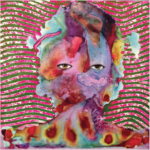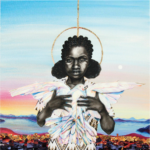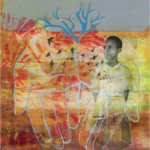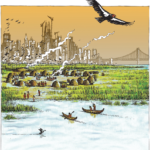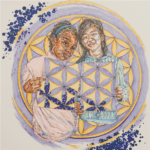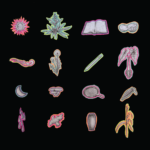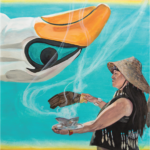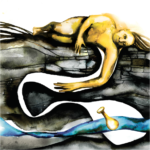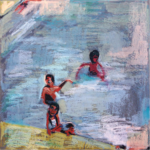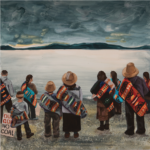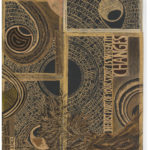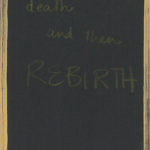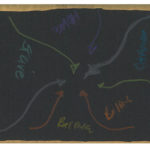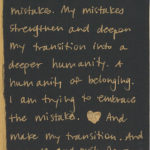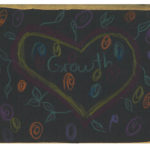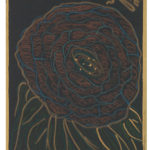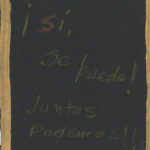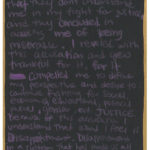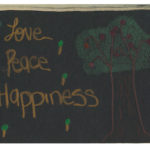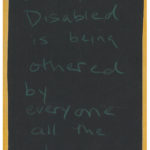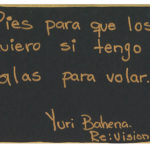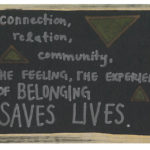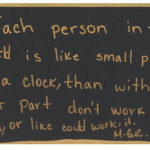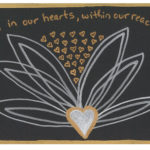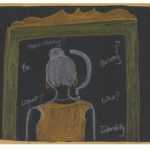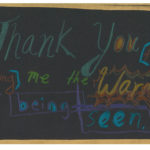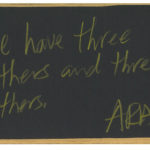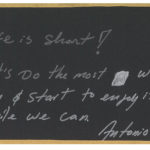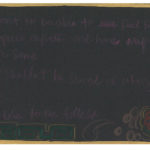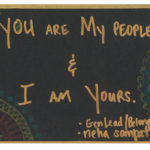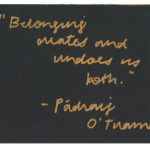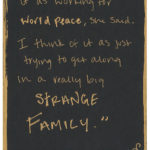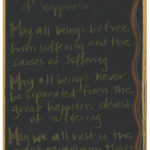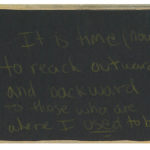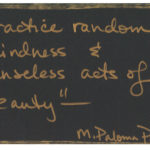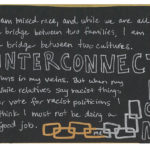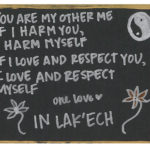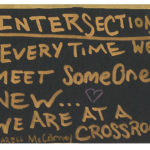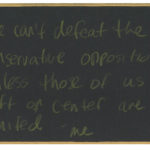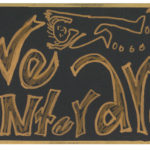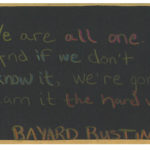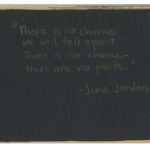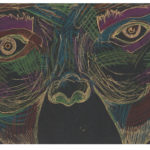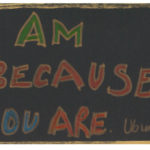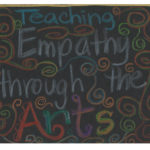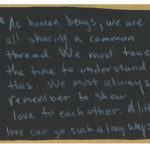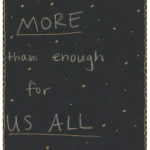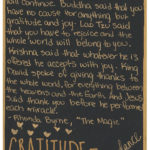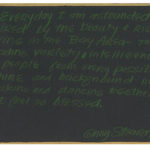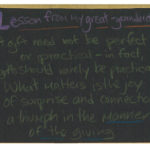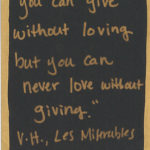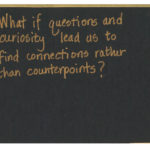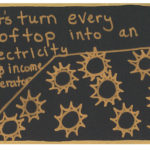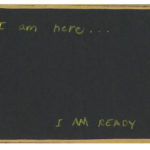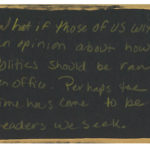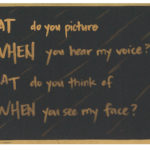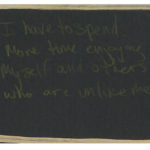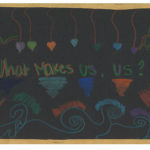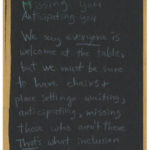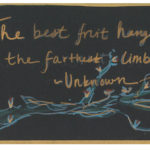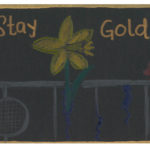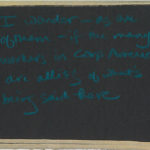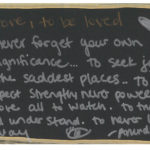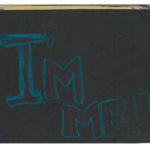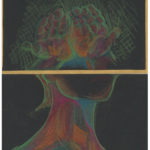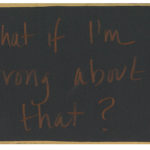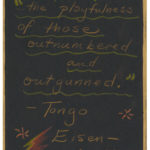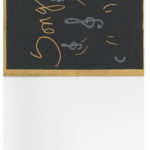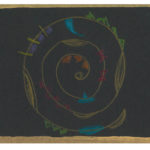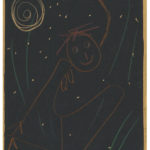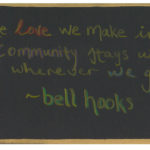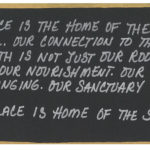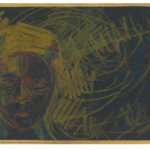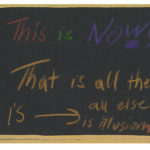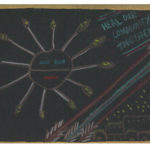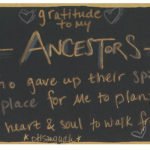- transition
- liberation
- belonging
- commons
- interconnection
- abundance
- sacred
- curiosity
- play
- place
Stories shape and reflect what is valued in a society; frames create the natural laws that give stories their gravity.
Frames shape how a story is told: what is emphasized and deemphasized, included and excluded. If the frame is individualism, then unions, community land trusts, and cooperative businesses are the stories of witches and thieves. If the frame is meritocracy, then affirmative action, reparations, maximum income, and guaranteed basic income are scientific impossibilities. If the frame is competition, then carbon taxes, the Environmental Protection Agency, free education, universal health care, and open borders are going the wrong direction down a one-way street. If the frame is othering, then a travel ban, controlling where someone goes to the bathroom, denying access to reproductive rights, environmental sacrifice zones, and racial profiling make perfect, plain, and common sense.
Worldviews are broad umbrellas of meaning; they can be subconscious and conscious, fluid and deeply rooted, widely spread and individualized.
While stories are shaped by frames, frames themselves are governed by the worldviews of the storyteller. Worldviews are broad umbrellas of meaning; they can be subconscious and conscious, fluid and deeply rooted, widely spread and individualized. Worldviews consist of collections of frames that distill how stories are told and which stories are told. The dominant frames of “othering” have deep roots on planet white supremacy (capitalist-hetero-patriarchal-ableist) but are not exclusive to that worldview.
Worldviews and frames also have long lives, frequently much longer than the stories that drive daily attention and focus. For the past four decades, right-wing billionaire Charles Koch has mounted an explicit attack on worldviews friendly to collectivism and public forms of government. As times change, this has led to attacks on healthcare, unions, and government regulations, but the underlying frames (anti-collective and pro-individual) remain.
In the domineering presence of destructive frames and worldviews, insurgent stories—those from the bottom and the cracks—have mastered the art of anti-gravity. They wiggle and dance their way through, and in their irreverence for the natural laws of the day, they destabilize the frames of oppressive and domineering worldviews. They carry with them a different set of frames and worldviews. As Arundhati Roy famously described, “Another world is not only possible, she’s on the way, and on a quiet day, if you listen carefully you can hear her breathe.”
These stories (which are also actions and lives) are not pure, nor perfectly aligned, and they may not even demonstrate short-term success or material outcomes. But as Robin D. G. Kelley describes, collective social movements are “incubators of new knowledge,” where the “most radical ideas often grow out of a concrete intellectual engagement with the problems of aggrieved populations confronting systems of oppression.” Engagements by groups and individuals to value life, liberation, and belonging create a wide field of stories. When these stories are studied and listened to carefully, patterns emerge. These patterns reveal frames, a small selection of which make up this collection.
“The world we want is one where many worlds fit.”
My own worldview which shapes this collection draws from the Zapatista idea that, “The world we want is one where many worlds fit.” In this way, this collection is not meant to be prescriptive—e.g., “use these frames to tell these stories in this way!”—nor, static—e.g., “this frame will help win, let’s use it for all our work.” Instead, stories, frames, and worldviews constantly inform and shape each other. For example, a person’s worldview rooted in belonging may add important frames around gender and intersectionality through the concrete actions of trans women of color advocating for prison abolition—as was my own experience through the work of the Transgender, Gender Variant, and Intersex Justice Project. Stories can and do shape frames and worldviews, just as worldviews and frames shape stories. As storytellers, there is a responsibility to understand the dynamic relationship between these levels when we choose which stories to tell and how we choose to tell them. We are never telling stories only on one level.
As an interdisciplinary creative person who works across issues, my interest in this book is in strengthening the connections between seemingly disparate stories through more clearly articulating shared frames. Mycelia are the underground branching parts of a fungus from which mushrooms spring when conditions are right. From a human point of view, the mushroom is the purpose of the mycelia. But from a fungal point of view, mushrooms spread the spores in order to grow the mycelia. For some people then, it may come as a surprise that one of the largest known organisms in the world is a 2,400 year old honey fungus in Oregon that is only seen when the conditions are right and lead to the appearance of thousands of mushrooms. As storytellers, I believe our work is similar: cultivating the branching parts that persist past the lifecycle of individual mushrooms, and producing the mushrooms that lead to the growth of the mycelium.
… Regardless of the success of a single campaign, action, or story, if we are also aware of our framing, we strengthen aligned future actions and stories.
How then does each story we tell help to grow mycelium that celebrate and support life, liberation, and belonging? In our isolated efforts, we may or may not be successful. But regardless of the success of a single campaign, action, or story, if we are also aware of our framing, we strengthen aligned future actions and stories. The 1969-1971 occupation of Alcatraz by the group Indians of All Tribes did not ultimately revert that land to Native control. But it did brilliantly (and playfully) articulate a frame of land-based self-determination that reverberates from the Occupy movement to Standing Rock to the Chicago Anti-Eviction Campaign. Do these other efforts claim that story as foundational to their work? I do not know. But taken together, these stories help each other make sense in a world that violently rages against territorial self-determination. These stories reimagine and retell the story outside of a frame of private property.
This collection is meant to strengthen the vision of a broad conception of storytellers: writers, painters, policymakers, educators, musicians, organizers, faith leaders, and funders, among many others. In our shared and disparate work we are all creating and we are all constantly telling stories. And these stories, whether we reflect on it or not, replicate and reinforce frames. Are these frames supportive of architectures of dominance or liberation? Of a worship of death or a celebration of life? A fear of the other or a struggle for a beloved community? Rarely is life so simple as to give a roadmap to these answers, and even more rarely is the answer one or the other—a yes or a no. This collection is not a roadmap, but a reflection of frames that live in the stories, actions, and lives of people who value life, liberation, and belonging. Our task as storytellers is to amplify the natural laws that make our anti-gravity stories make perfect, plain, and common sense.
~Frames~
This is a collection of ten images created by various artists, each accompanied by additional drawings (the small black ones) created by attendees of the 2017 Othering & Belonging Conference, as well as quotes that illustrate the theme of each image.
Transition
Art by Firelei Báez1)Active Boundaries (July 11th) Lacquer ink and fluid acrylic on paper
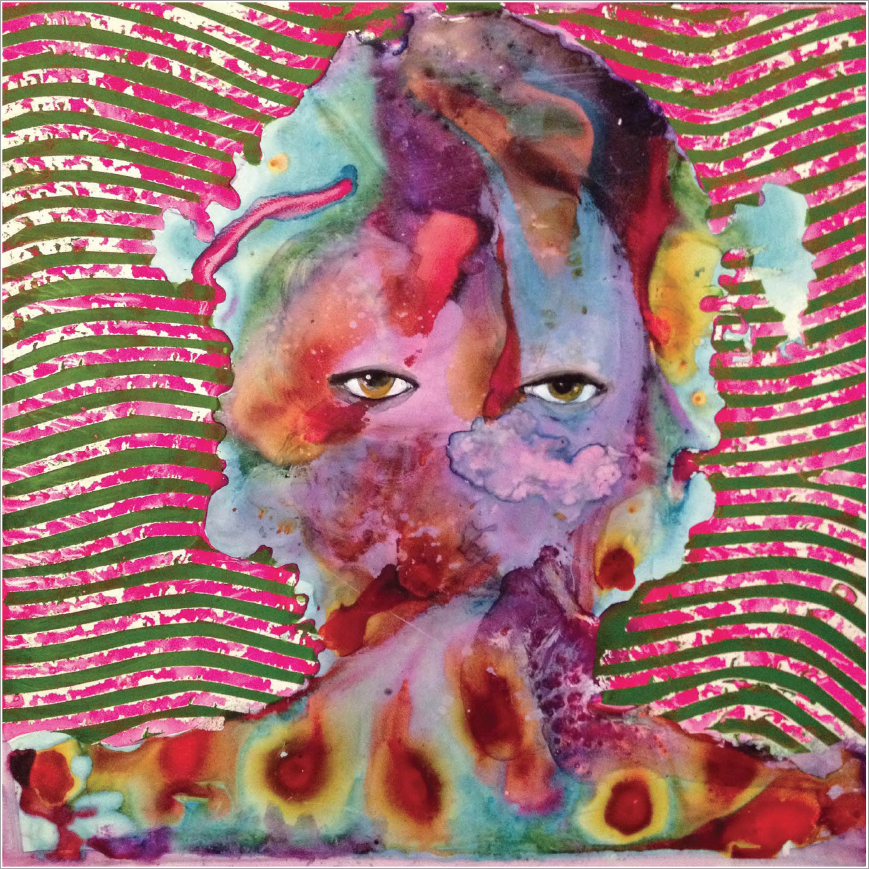
- The best part of your story is when it changes.
- death and then REBIRTH.
- Move, Change, Belong, Become, Strive.
- As I learn I will make mistakes. My mistakes strengthen and deepen my transition into a deeper humanity. A humanity of belonging. I am trying to embrace the mistakes. And make my transition. And promote and push for society’s transition.
- Growth
- Culture
- ¡Si, se puede! Juntos Podemos!! Yes, you can! Together we can!
“Life is tragic simply because the earth turns and the sun inexorably rises and sets, and one day, for each of us, the sun will go down for the last, last time. Perhaps the whole root of our trouble, the human trouble, is that we will sacrifice all the beauty of our lives, will imprison ourselves in totems, taboos, crosses, blood sacrifices, steeples, mosques, races, armies, flags, nations, in order to deny the fact of death, which is the only fact we have. It seems to me that one ought to rejoice in the fact of death—ought to decide, indeed, to earn one’s death by confronting with passion the conundrum of life.”
James Baldwin2)Baldwin, James. The Fire Next Time. 1st Vintage International ed. New York: Vintage International Vintage Books, 1993.
“All that you touch
You Change.
All that you Change
Changes you.
The only lasting truth
is Change.”
Octavia Butler3)Butler, Octavia E. Parable of the Talents: A Novel. A Seven Stories Press 1st ed. New York: Seven Stories Press, 1998.
“We should not be waiting for singular charismatic leaders to tell us what direction to go, but instead be like midwives, supporting the birth of movements that are already emerging.” Grace Lee Boggs “At stake is not only how we fight to win, but also how prepared we are for victories. Prepare to win means be ready for the morning after.”
Ruth Wilson Gilmore4)This quote comes from a conversation between Invincible and Grace Lee Boggs. For more on this, see: https://emergencemedia.org/pages/about-us.
“Take it to the bridge.”
James Brown5)Brown, James. Get Up (I Feel Like Being A) Sex Machine. Song. Star Time, 1970.
Liberation
Art by Nicole Dixon6)As a Feather
Acrylic, colored pencil, fabric, charcoal, magazine paper, chalk, gold leaf on canvas
In “As a Feather,” Dixon re-envisions the ancient Egyptian premise of the heart needing to be as light as a feather to pass into the afterlife. Her figure serves as a touchstone for the Black community, and Black women in particular, to do the spiritual work necessary to survive oppression and transcend the onslaught of their embodied sufferings—that their hearts may be as light as a feather, both in this world as they struggle toward liberation and in the next.
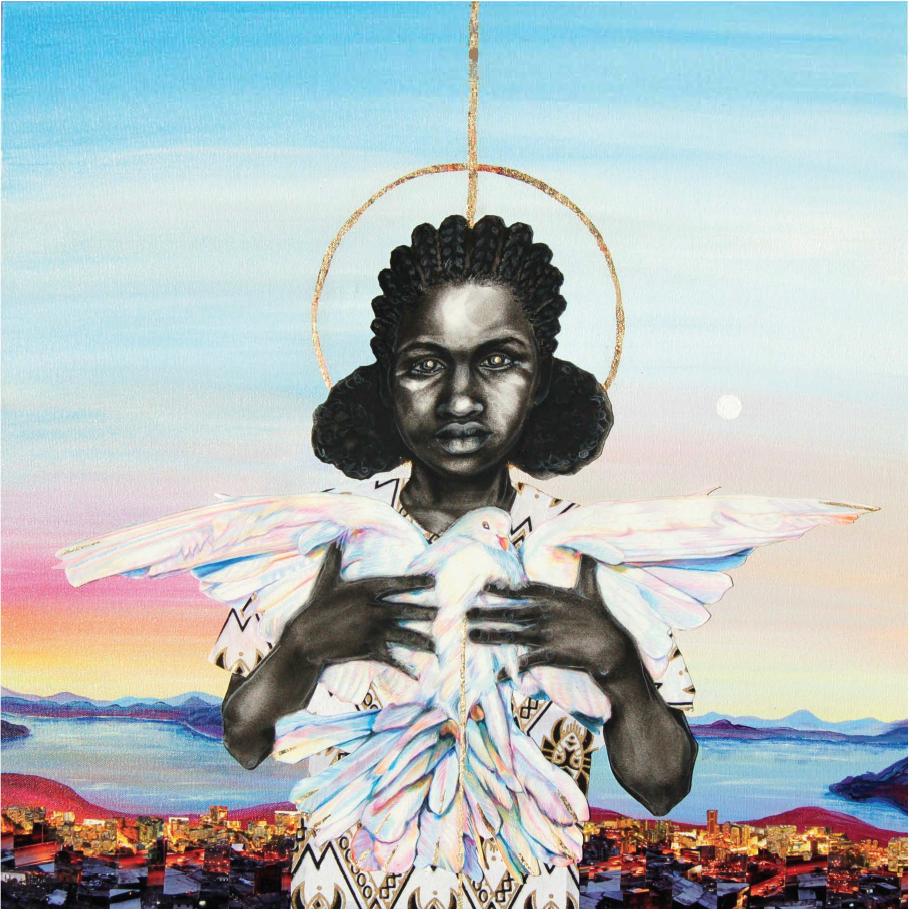
“We know that there is no help for us but from one another, that no hand will save us if we do not reach out our hand. And the hand that you reach out is empty, as mine is. You have nothing. You possess nothing. You own nothing. You are free. All you have is what you are, and what you give.”
Ursula K. Le Guin7)Le Guin, Ursula K. The Dispossessed: A Novel. 1st Perennial Classics ed. New York: Perennial Classics, 2003.
“When we live outside ourselves, and by that I mean on external directives only rather than from our internal knowledge and needs, when we live away from those erotic guides from within ourselves, then our lives are limited by external and alien forms, and we conform to the needs of a structure that is not based on human need, let alone an individual’s. But when we begin to live from within outward, in touch with the power of the erotic within ourselves, and allowing that power to inform and illuminate our actions upon the world around us, then we begin to be responsible to ourselves in the deepest sense.”
Audre Lorde8)Lorde, Audre. Sister Outsider: Essays and Speeches. The Crossing Press Feminist Series. Trumansburg, NY: Crossing Press, 1984.
“Authentic liberation—the process of humanization—is not another deposit to be made in men. Liberation is a praxis: the action and reflection of men upon their world in order to transform it.”
Paolo Freire9)Freire, Paulo. Pedagogy of the Oppressed. 30th anniversary ed. New York: Continuum, 2003.
Nina Simone10)“Freedom Is a Feeeling! Freedom Is No Fear!” – Nina Simone – New York, 1968, 2016. https://www.youtube.com/watch?v=nPD8f2m8WGI.: Well what’s freedom? What’s free to me? Same thing to you as it is to me, you tell me.
Interviewer: No, you tell me.
Simone: It’s just a feeling. It’s just a feeling, it’s like how do you tell somebody how it feels to be in love? How are you going to tell anybody who hasn’t been in love what it feels to be in love? You can describe things but you can’t tell him. But you know it when it happens. That’s what I mean by free. I’ve had a couple times on stage when I’ve really felt free and that’s something else, that’s really something else. Oh, I’ll tell you what freedom is to me. No fear. I mean really no fear.
“…it was not enough to break the chains; it was necessary to master the ship.”
Vincent Harding11)Harding, Vincent. There Is a River: The Black Struggle for Freedom in America. Houghton Mifflin Harcourt, 1981.
Belonging
Art by Shanna Strauss12)Untitled Mixed media on found wood
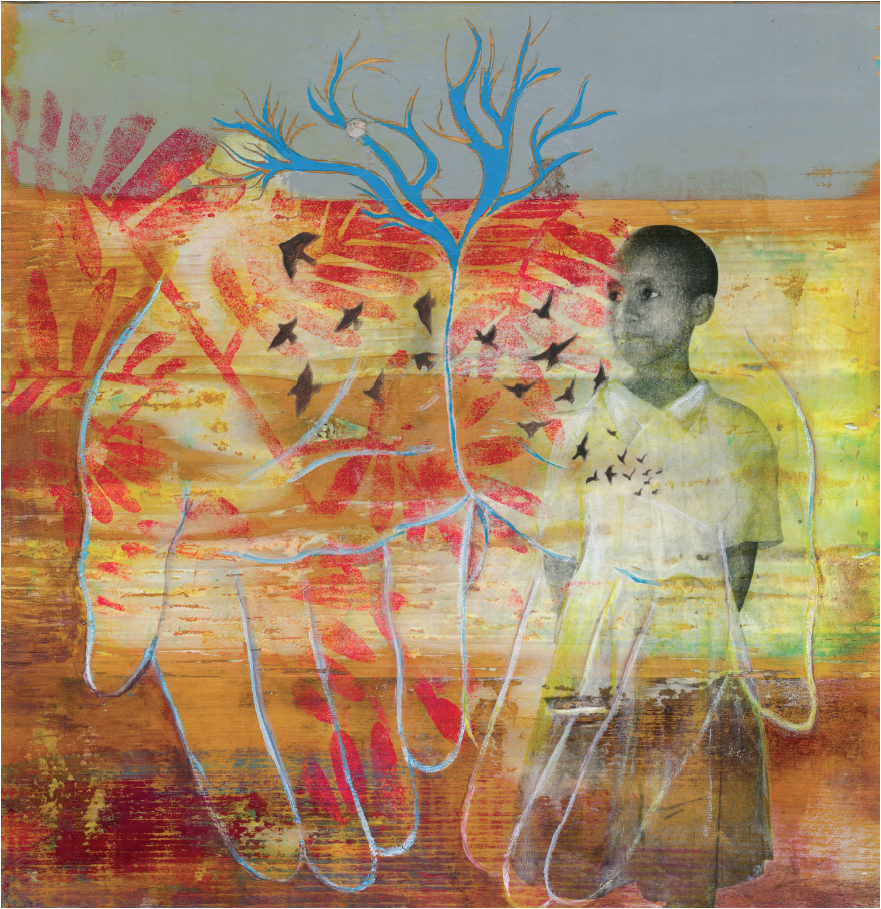
- Recently, I was told by my very own mother and the father of my children that they don’t understand me in my fight for justice, and they concluded in accusing me of being miserable. I reveled with this accusation and grew thankful for it, for it compelled me to define my perspective and desire to continue fighting for social, economic, educational, political, racial, gender, etc. JUSTICE. Because of this accusation I understand that what I feel is disappointment. Disappointment in a system that has made us all the subjects of its manipulation. Disappointment in the mothers and fathers that never were, don’t desire to be, and never will be…
- Love, Peace, Happiness
- Being disabled is being othered by everyone all the time.
- Pies para que los quiero si tengo alas para volar. (Feet so I want them if I have wings to fly.)
- Connection, relation, community, the feeling, the experience of belonging saves lives.
- Each person in this world is like a small pize of a clock, than without that part don’t work good, or like could work it.
- What we need is in our hearts, within our reach, ready to give 🙂
- How many? Be. Belong? What? Who? Identity.
- Thank you for giving me the warmth of being seen.
- We have three fathers and three mothers.
- #DisabilityJustice #DisabilitySolidarity #DecriminalizeDisability
- Life is short! Let’s do the most we can & start to enjoy it while we can.
- I want to be able to feel free to express myself and have my family do the same. You shouldn’t be scared of who you are. Live life to the fullest.
- You are my people & I am yours.
- “Belonging creates and undoes us both.” ~Padraig O’Tuama
- “I don’t think of it as working for world peace, she said. I think of it as just trying to get along in a really big strange family.” ~Story People
“The knowing self is partial in all its guises, never finished, whole, simply there and original; it is always constructed and stitched together imperfectly, and therefore able to join with one another, to see together without claiming to be another.”
Donna Haraway13)Haraway, Donna. “Situated Knowledges: The Science Question in Feminism and the Privilege of Partial Perspective.” Feminist Studies 14, no. 3 (1988): 575–99. doi:10.2307/3178066.
“Where do we find that space of connecting, of belonging? If you have love, you have the community of belonging that comes with it.”
Bell Hooks14)Hooks, Bell. Belonging: A Culture of Place. New York: Routledge, 2009.
“I am like the desert shrubs out there. The wind may blow, it may change, but I have deep roots and I know where the water is at.”
Laurie Weahkee15)Laura Weakhee, Diné and Zuni, as quoted in: LaDuke, Winona. Recovering the Sacred: The Power of Naming and Claiming. 1st ed. Cambridge, MA: South End Press, 2005.
“I do not think of political power as an end. Neither do I think of economic power as an end. They are ingredients in the objective that we seek in life. And I think the end of that objective is a truly brotherly society, the creation of the beloved community.”
Martin Luther King, Jr.16)King, Jr., Martin Luther, and Alex Ayres. The Wisdom of Martin Luther King, Jr. Meridian, 1993.
“We’re all born naked and the rest is drag.”
Ru Paul17)Paul, Ru. Born Naked. Song. Born Naked, 2014.
“Belonging is the most important good we distribute in society, as it is prior to and informs all other distributive decisions. We must support the creation of structures of inclusion that recognize and accommodate difference, rather than seek to erase it. We need practices that create voice without denying our deep interrelationship.”
john a. powell and Stephen Menendian18)powell, john a., and Stephen Menendian. “The Problem of Othering: Towards Inclusiveness and Belonging.” Othering and Belonging, June 29, 2016. http://www.otheringandbelonging.org/the-problem-of-othering/.
Commons
Art by Fernando Marti19)The View from Ohlone / Mission Bay: 1776-2016. Ink, watercolor and digital colors.
The Commons: before this land was colonized, fenced in and privatized, subdivided, commodified, and resold by realtors and speculators. The city is not going away. But even as capital seeks to extend its grip to our water and air, we remember, and fight back. The land will be free again, held in common trust by and for the people, for this and future generations.
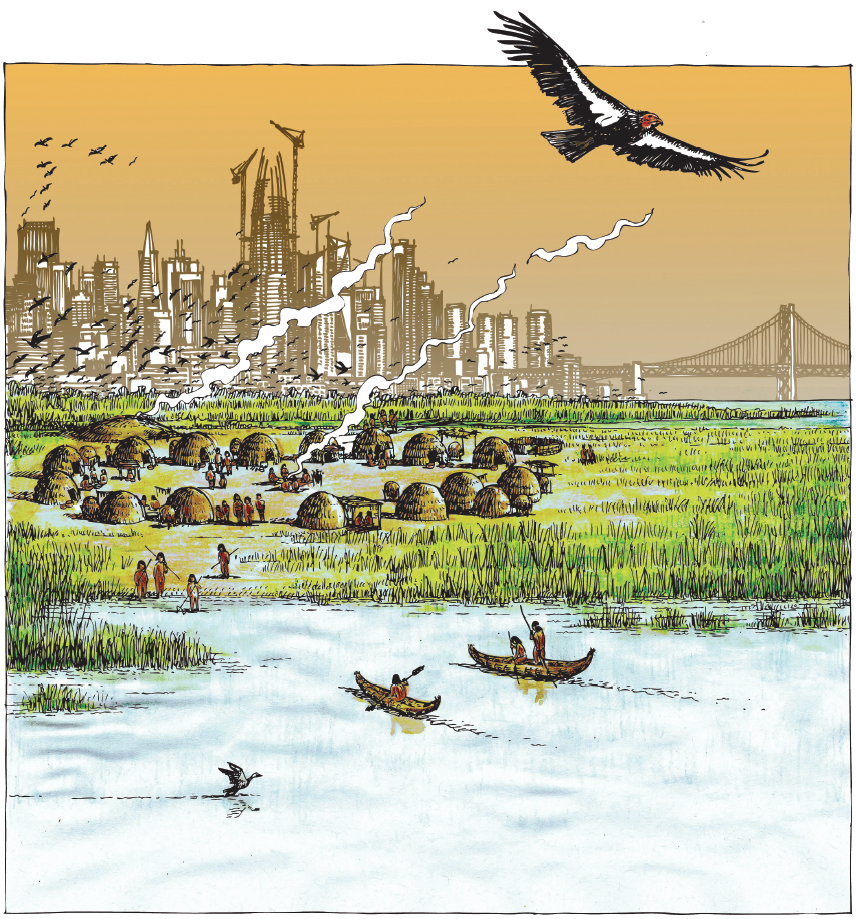
- May all beings have happiness and the causes of happiness. May all beings be free from suffering and the causes of suffering. May all beings never be separated from the great happiness devoid of suffering. May we all rest in the great equanimity that is free from attachment and aversion.
- It is time (now) to reach outward and backward to those who are where I used to be.
- “Practice random kindness and senseless acts of beauty” ~M.Paloma Pavel
“This is a clear mandate of the people, simple but very profound. We are going from a model where everything—trees, animals, water—is converted into merchandise or commodities to another model of where these things belong to everyone.”
Oscar Olivera20)Olivera, Oscar, and Tom Lewis. Cochabamba!: Water War in Bolivia. Cambridge, Mass: South End Press, 2004.
“Communality (comunalidad) is the strength of the community and the space that re-creates it. It is the ground where our future grows, it is the cradle of our natural thought and after all is said and done, it is the opportunity to think of a different future world closer to us, but also closer and more necessary for the world. It’s enough to underline that communality made of our social organization a fabric of greater harmonic possibilities, not exempt from contradictions, not exempt from stratifications, but closer to dialogue, closer to consensus, to collective reflection and to horizontal decision making. The communal marks the rhythm of production and opens innovative spaces for the education of our children. The communal, after all, is for us a fundamental element for understanding our new potentialities.”
Jaime Martínez Luna21)Martinez Luna, Jaime. “Communality and Autonomy; a Compilation of Three Essays and Two Declarations by Indians of the Northern Sierra of Oaxaca.” Accessed April 18, 2017. http://site.www.umb.edu/faculty/salzman_g/Strate/Commu/index.htm.
“All members of the Earth Community including all humans have the right to sustenance—to food and water, to safe and clean habitat, to security of ecological space. These rights are natural rights, they are birthrights given by the fact of existence on earth and are best protected through community rights and commons. They are not given by states or corporations, nor can they be extinguished by state or corporate action. No state or corporation has the right to erode or undermine these natural rights or enclose the commons that sustain all through privatisation or monopoly control.”
Vandana Shiva22)Shiva, Vandana. Earth Democracy: Justice, Sustainability, and Peace. Cambridge, Mass: South End Press, 2005.
“Why is it easier to imagine the end of the world than the end of capitalism?”
Multiple attributions (Fredric Jameson and Slavoj Žižek)
Interconnection
Art by Brett Cook23)Interconnectedness Ink and paint on Arches paper.
This image of two friends is from Brett Cook’s project Identity of Interbeing: Recognizing Difference and Seeing Ourselves, at Packer Collegiate Academy, Brooklyn New York in 2006. The project is featured in What We Made: Conversations on Art and Social Cooperation (Finkelpearl, Tom. Durham, NC: Duke University Press, 2013), Ch. 10 “Unburning Freedom Hall and the Packer School Project—Spirituality and Cooperation, in conversation with Mierle Landerman Ukeles.” A version of this image was then featured in Clouds in a Teacup: A Mindful Journey and Coloring Book (Berkeley, CA: Parallax Press, 2016) created with global spiritual leader Thich Nhat Hanh.
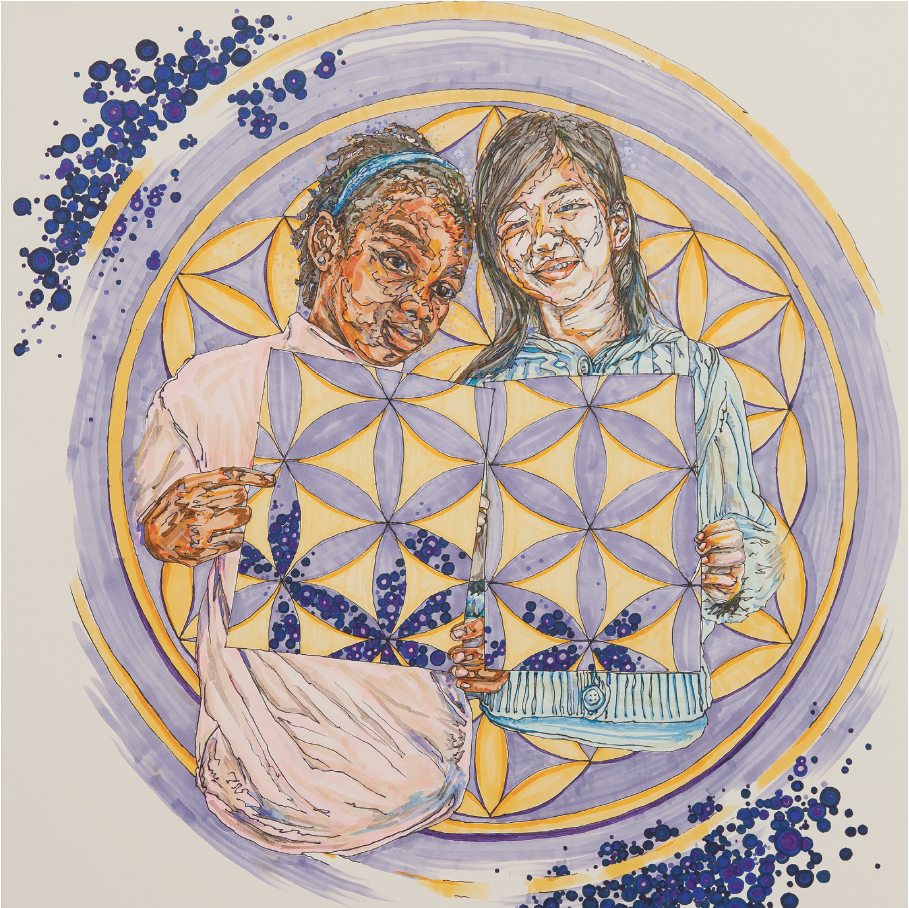
- I am mixed race, and while we are all a bridge between two families, I am a bridge between two cultures. INTERCONNECTION runs in my veins. But when my white relatives say racist things or vote for racist politicians I think I must not be doing a good job.
- You are my other me. If I harm you, I harm myself. If I love and respect you, I love and respect myself. One Love. In Lak’ech.
- Intersections. “Every time we meet someone new… we are at a crossroad” ~Tarell McCraney
- We can’t defeat the conservative opposition unless those of us left of center are united.
- we interare
- We are all one. And if we don’t know it, we’re gonna learn it the hard way. Bayard Rustin
- “There is no chance we will fall apart. There is no chance- there are no parts.” ~June Jordan
- I am because you are. Ubuntu
- Teaching Empathy through the Arts.
“The individual is not the smallest unit of society any more than an individual plant or animal is the smallest unit of an ecosystem. The relationship is the smallest unit of society; just as the relationship is the smallest unit of an ecosystem. It is the complex of relationships that make up an ecosystem and it is the complex of relationships that make up a society.”
Movement Generation24)See: http://movementgeneration.org/
“We are a part of everything that is beneath us, above us, and around us. Our past is our present, our present is our future, and our future is seven generations past and present.” Haudenosaunee Teaching25)As quoted in: LaDuke, Winona. All Our Relations: Native Struggles for Land and Life. Cambridge, MA : Minneapolis, MN: South End Press ; Honor the Earth, 1999.
“One day, I offered a number of children a basket filled with tangerines. The basket was passed around, and each child took one tangerine and put it in his or her palm. We each looked at our tangerine, and the children were invited to meditate on its origins. They saw not only their tangerine, but also its mother, the tangerine tree. With some guidance, they began to visualize the blossoms in the sunshine and in the rain. Then they saw petals falling down and the tiny green fruit appear. The sunshine and the rain continued, and the tiny tangerine grew. Now someone has picked it, and the tangerine is here… Each time you look at a tangerine, you can see deeply into it. You can see everything in the universe in one tangerine.”
Thich Nhat Hanh26)Hanh, Thich Nhat. Peace Is Every Step: The Path of Mindfulness in Everyday Life. Bantam Books, 1991.
“And I repeat: The price of the liberation of the white people is the liberation of the blacks—the total liberation, in the cities, in the towns, before the law, and in the mind.”
James Baldwin27)Baldwin, James. The Fire next Time. 1st Vintage International ed. New York: Vintage International Vintage Books, 199
“In the late spring we plant the corn and beans and squash. They’re not just plants—we call them the three sisters. We plant them together, three kinds of seeds in one hill. They want to be together with each other, just as we Indians want to be together with each other. So as long as the three sisters are with us, we know we will never starve. The creator sends them to us each year. We celebrate them now.”
Chief Louis Farmer28)Chief Louis Farmer, Onondaga, as quoted in: LaDuke, Winona. Recovering the Sacred: The Power of Naming and Claiming. 1st ed. Cambridge, MA: South End Press, 2005.
Abundance
Art by Evan Bissell29)4 energy sources, 4 medicines, 4 tools, 4 foods Pencil and ink on paper
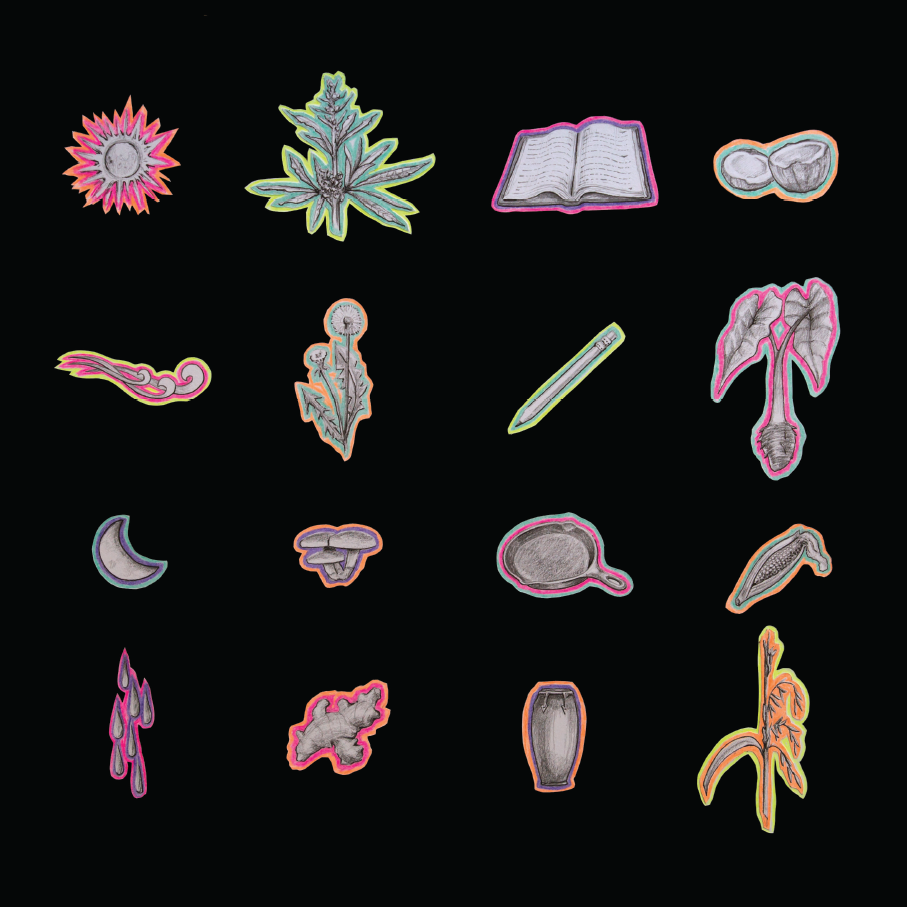
- “As human beings, we are all sharing a common thread. We must take the time to understand this. We must always remember to show love to each other. A little love can go such a long ways.
- There is more than enough for us all. ~Ali Brooks
- Muhammad said that gratitude for the abundance you’ve received is the best insurance that the abundance will continue. Buddha said that you have no cause for anything but gratitude and joy. Lao Tzu said that you have to rejoice and the whole world will belong to you. Krishna said that whatever he is offered he accepts with joy. King David spoke of giving thanks to the whole world, for everything between the heavens and the Earth. And Jesus said thank you before he performed each miracle. ~Rhonda Byrne, “The Magic”. GRATITUDE = abundance
- Every day I am astounded and inspired by the beauty and richness of living in the Bay Area- the dazzling variety and intelligence of people from every possible culture and background living, working and dancing together. I feel so blessed. ~Ginny Stearns
- A Lesson from my great-grandmother: A gift need not be perfect or practical- in fact, gifts should rarely be practical. What matters is the joy of surprise and connection, a triumph in the manner of the giving.
- “You can give without loving but you can never love without giving.” V.H., Les Miserables
- What if questions and curiosity lead us to find connections rather than counterpoints?
- Let’s turn every rooftop into an electricity & income generator.
“This could be our revolution:
To love what is plentiful
as much as
what’s scarce.”
Alice Walker30)From the poem “We Alone” in: Walker, Alice. Her Blue Body Everything We Know: Earthling Poems, 1965-1990. 1st ed. San Diego: Harcourt Brace Jovanovich, 1991.
“For there are no new ideas. There are only new ways of making them felt.”
Audre Lorde31)Lorde, Audre. Sister Outsider: Essays and Speeches. The Crossing Press Feminist Series. Trumansburg, NY: Crossing Press, 1984.
“In the beginner’s mind there are many possibilities, but in the expert’s there are few.”
Suzuki Roshi32)As quoted in: Chodron, Pema. The Places That Scare You: A Guide to Fearlessness in Difficult Times. Shambhala Publications, 2002
“…the secret of the Great Stories is that they have no secrets. The Great Stories are the ones you have heard and want to hear again. The ones you can enter anywhere and inhabit comfortably. They don’t deceive you with thrills and trick endings. They don’t surprise you with the unforeseen. They are as familiar as the house you live in. Or the smell of your lover’s skin. You know how they end, yet you listen asthough you don’t. In the way that although you know that one day you will die, you live as though you won’t. In the Great Stories you know who lives, who dies, who finds love, who doesn’t. And yet you want to know again.”
Arundhati Roy33)Roy, Arundhati. The God of Small Things. 1st HarperPerennial ed. New York: HarperPerennial, 1998.
“Joy, my love, joy in all things,
in what falls and what flourishes.
Joy in today and yesterday,
the day before and tomorrow.”
Pablo Neruda34)From the poem “How much happens in a day” in: Neruda, Pablo, and Alastair Reid. Extravagaria. 1st Farrar, Straus and Giroux pbk., bilingual ed. New York: Farrar, Straus and Giroux, 1975.
Sacred
Art by Jewell Praying Wolf James and Evan Bissell, based on a photo by Paul Anderson35)Totem pole designed and carved by Master Carver Jewell Praying Wolf James and the Lummi Nation’s House of Tears Carvers. Mr. James also directed the Totem Pole Journey team. Painting by Evan Bissell, based on a photo by Paul Anderson. Acrylic on canvas.
Totem Pole Journey Blessing
The totem pole journeys bring attention to the threat fossil fuel extraction, transport by train and pipeline, and export to Asia pose to our natural and cultural heritage. Since 2013 Mr. James has carved and transported four totem poles a total of 32,000 miles. The 23’ totem poles now stand in British Columbia (Canada), Alberta (Canada), Billings (Montana), and the one in the image, in Manitoba (Canada). The totem pole is an artful messenger, a creative symbol, and a powerful catalyst for raising public awareness, empowering and helping to unify local communities, and educating the general public through public events, tribal gatherings, and mainstream as well as social media. As Mr. James goes to great lengths to point out, “It is not the totem pole that is sacred. What is sacred is the people gathering together in the spirit of ceremony for the power of one mind, one heart.”
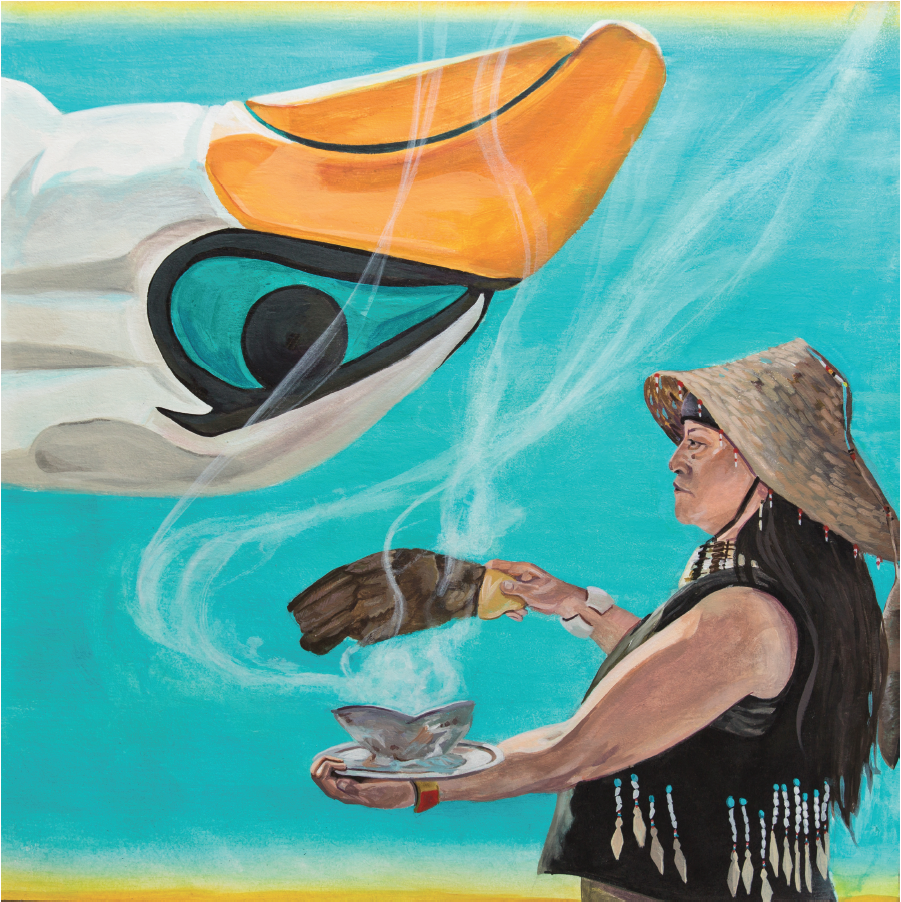
“In our worldviews, we are beings who come from the Earth, from the water, and from the corn. The Lenca people are ancestral guardians of the rivers, in turn protected by the spirits of young girls, who teach us that giving our lives in various ways for the protection of the rivers is giving our lives for the well-being of humanity and of this planet.”
Berta Cáceres36)Goldman Environmental Prize. Berta Caceres Acceptance Speech, 2015 Goldman Prize Ceremony, 2015. https://www.youtube.com/watch?v=AR1kwx8b0ms.
“The death toll is always one, plus one, plus one, plus one. The death toll is always one.”
Teju Cole37)Cole, Teju. “Vijay Iyer’s Blindspot with Teju Cole.” SF Jazz Center, 2017.
“To us, as caretakers of the heart of Mother Earth, falls the responsibility of turning back the powers of destruction. You yourself are the one who must decide.”
Chief Arvol Looking Horse38)Chief Arvol Looking Horse. “Important Message from Keeper of Sacred White Buffalo Calf Pipe.” Indian Country Media Network, August 26, 2016. https://indiancountrymedianetwork.com/news/opinions/important-message-from-keeper-of-sacred-white-buffalocalf-pipe/.
“It is our duty to fight for our freedom.
It is our duty to win.
We must love each other and support each other.
We have nothing to lose but our chains.”
Assata Shakur39)Shakur, Assata. “To My People (written While in Prison),” July 4, 1973. http://www.assatashakur.org/mypeople.htm.
“Life is a learning place, existence is forever.”
Leonard Peltier40)Peltier, Leonard. “Message to Youth from Leonard Peltier,” March 2006. http://www.nativevillage.org/Messages%20from%20the%20People/Lenoard%20Peltier%20Area/3-15%20greetings_my_relatives.htm.
Curiosity
Art by Micah Bazant41)Curiosity
Watercolor on paper. So much is unseen, calling to us like underground rivers. Curiosity helps us reach through time, into imagined spaces.
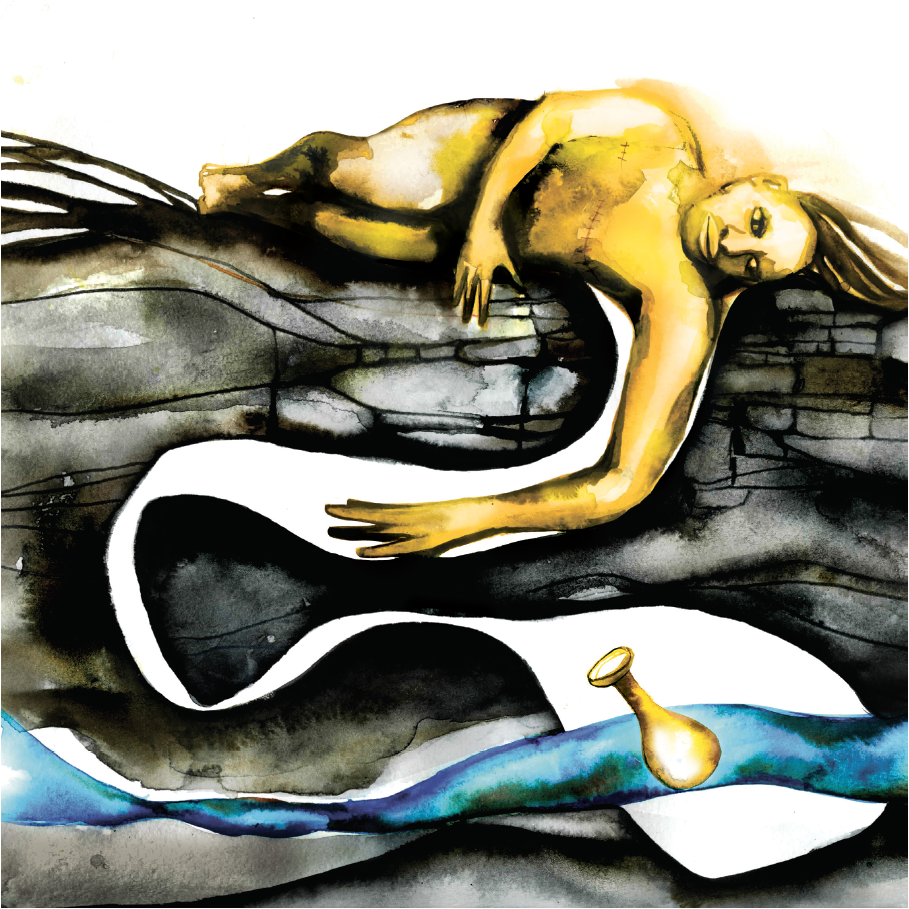
- I am here… I am ready.
- What if those of us with an opinion about how politics should be ran for office. Perhaps the time has come to be leaders we seek.
- What do you picture when you hear my voice? What do you think of when you see my face?
- I have to spend more time enjoying myself and others who are unlike me.
- What makes us, us?
- Waiting for you Missing you Anticipating you… We say everyone is welcome at the table, but we must be sure to have chairs and place settings waiting, anticipating, missing those who aren’t there. That’s what inclusion looks like.
- The best fruit hangs on the farthest limb. ~unknown
- Stay gold.
- I wonder- as one of them- if the many workers in Corporate America are allies of what’s being said there.
- To love, to be loved, To never forget your own insignificance… to seek joy in the saddest places… to respect strength, never power. Above all to watch. To try and understand. To never look away
- I’m me!
- What if I’m wrong about that?
“ ‘A‘ohe pau ka ‘ike i ka hālau ho‘okahi
All knowledge is not taught in one school
One can learn from many sources.”
M.K. Pukui (Hawaiian proverb)42)From M.K. Pukui’s Hawaiian Proverbs and Poetical Sayings, as quoted in: Meyer, Manulani Aluli. Hoʻoulu: Our Time of Becoming : Collected Early Writings of Manulani Meyer. ʻAi Pōhaku Press, 2003.
“And we don’t come to you to tell you what you should do nor to give you orders…
What we are going to do is listen to your thoughts.”
EZLN (Zapatista Army of National Liberation)43)Zapatista Army of National Liberation. “What We Want to Do, How We Are Going to Do It; Sixth Declaration of the Lacandon Jungle,” July 1, 2005. http://www.narconews.com/Issue38/article1371.html.
“In the poetics of struggle and lived experience, in the utterances of ordinary folk, in the cultural products of social movements, in the reflections of activists, we discover the many different cognitive maps of the future, of the world not yet born.”
Robin D.G. Kelley44)Kelley, Robin D. G. Freedom Dreams: The Black Radical Imagination. Boston: Beacon Press, 2002.
“Wherever there is a problem, there are already people acting on the problem in some fashion.”
Allied Media Projects45)Allied Media Projects. “Allied Media Projects Network Principles.” Allied Media Projects, December 14, 2011. https://www.alliedmedia.org/about/network-principles.
“The starting-point of critical elaboration is the consciousness of what one really is, and is‘knowing thyself’ as a product of the historical process to date, which has deposited in you an infinity of traces, without leaving an inventory. Therefore it is imperative at the outset to compile such
an inventory.”
Antonio Gramsci46)From Antonio Gramsci’s The Prison Notebooks, As quoted in: Said, Edward W. Orientalism. New York: Vintage Books, 1994.
Play
Art by Susu Attar47)Swimming with my Brothers and Them
Oil pastel on paper
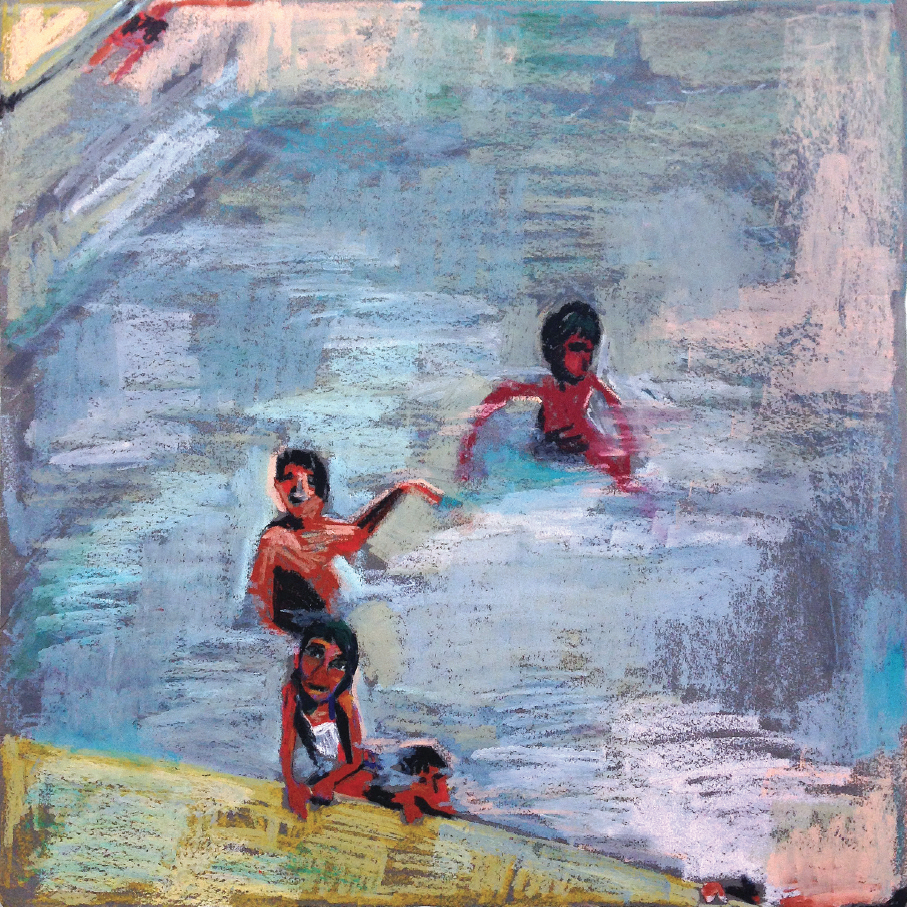
- Play… “the playfulness of those outnumbered and outgunned.” ~Tongo Eisen-Martin
- Song
“We, the native Americans, re-claim the land known as Alcatraz Island in the name of all American Indians by right of discovery. We wish to be fair and honorable in our dealings with the Caucasian inhabitants of this land, and hereby offer the following treaty: We will purchase said Alcatraz Island for twenty-four dollars ($24) in glass beads and red cloth, a precedent set by the white man’s purchase of a similar island about 300 years ago…”
Indians of All Tribes, Alcatraz Proclamation48)Indians of All Tribes. “1969 Occupation of Alcatraz and the Alcatraz Proclamation,” November 1969. http://www.nativevillage.org/Inspiration-/Occupation%20of%20Alcatraz%20and%20the%20Alcatraz%20Proclamation%20alcatraz_proclamation.htm#Alcatraz%20Proclamation.
“I asked one fellow, “How did you join the civil rights movement?” He said, “I heard you all marching and singing one day and I jumped over the fence from my job and I joined you all marching and singing. I’m gonna do what the spirit says do.”
Dorothy Cotton49)Cotton, Dorothy. Editor interview with Dorothy Cotton, 2013.
“Especially—don’t lose your sense of humor, even when the laughter is at your own expense.”
Leonard Peltier50)Peltier, Leonard. “Message to Youth from Leonard Peltier,” March 2006. http://www.nativevillage.org/Messages%20from%20the%20People/Lenoard%20Peltier%20Area/3-15%20greetings_my_relatives.htm.
“Reason, I sacrifice you to the evening breeze. You call yourself the language of order? For me it is the lash of the whip. But oh, there is the hoarse contraband of my laughter, my treasure of saltpepper! For we hate you, you and your reason, for we appeal to the dementia praecox of the flowering absurdity of a stubborn cannibalism. Our treasures, then, are the madness that remembers, the madness that roars, the madness that sees, the madness that breaks loose.”
Aimé Césaire51)Césaire, Aimé, Mireille Rosello, and Annie Pritchard. Notebook of a Return to My Native Land =: Cahier D’un Retour Au Pays Natal. Bloodaxe Contemporary French Poets 4. Newcastle upon Tyne, England: Bloodaxe Books, 1995.
“The Church says: the body is a sin.
Science says: the body is a machine.
Advertising says: The body is a business.
The Body says: I am a fiesta.”
Eduardo Galeano52)Galeano, Eduardo, and J. Borges. Walking Words. New York, N.Y: W.W. Norton, 1997.
Place
Art by Evan Bissell based on a photo by Paul Anderson53)Based on a photo by Paul Anderson. Acrylic on paper.
Victory at Xwe’chi eXen, 2016
In the spring of 2016, the Lummi Nation won a historic victory against what was proposed to be the largest coal export terminal in North America at Xwe’chi eXen (otherwise known as Cherry Point). Citing treaty fishing rights, the Lummi argued that the terminal would have destroyed their way of life. After the Army Corps of Engineers denied the permit for the terminal, Lummi Nation Chairman Tim Ballew II stated, “Because of this decision, the water we rely on to feed our families, for our ceremonies and for commercial purposes remains protected. But this is more than a victory for our people; it’s a victory for treaty rights.”
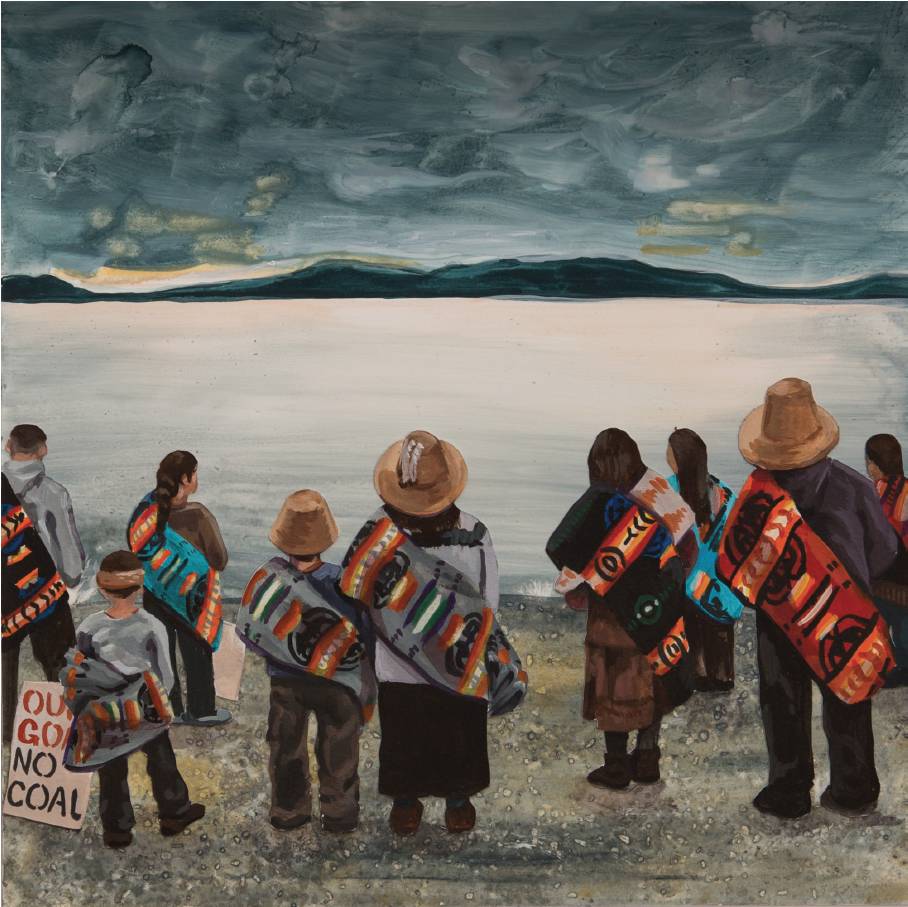
- The love we make in community stays with us wherever we go. ~Bell Hooks
- Place is the home of the soul. Our connection to the earth is not just our roots but our nourishment. Our belonging. Our sanctuary. Place is the home of the soul.
- This is now! That is all there is -> all else is illusion
- Heal our community together.
- gratitude to my ancestors who gave up their space & place for me to plant my heart & soul to walk freely
“Without land there is no community.”
Jaime Martínez Luna54)Martinez Luna, Jaime. “Communality and Autonomy; a Compilation of Three Essays and Two Declarations by Indians of the Northern Sierra of Oaxaca.” Accessed April 18, 2017. http://site.www.umb.edu/faculty/salzman_g/Strate/Commu/index.htm.
“You can go home again… so long as you understand that home is a place you have never been.”
Ursula K. Le Guin55)Le Guin, Ursula K. The Dispossessed: A Novel. 1st Perennial Classics ed. New York: Perennial Classics, 2003.
“When my children are born, I want them to be born into a world where hope and transformation are possible. I want them to be born into a world where stories still have power. I want them to grow up able to be Heiltsuk in every sense of the word. To practice the customs and understand the identity that has made our people strong for hundreds of generations. That cannot happen if we do not sustain the integrity of our territory, the lands and waters, and the stewardship practices that link our people to the landscape. On behalf of the young people in my community, I respectfully disagree with the notion that there is any compensation to be made for the loss of our identity, for the loss of our right to be Heiltsuk.”
Jess Housty56)As quoted in: Klein, Naomi. This Changes Everything: Capitalism vs. the Climate. First Simon & Schuster hardcover edition. New York: Simon & Schuster, 2014.
“As a citizen of this city for some thirty years, I am constantly struck that no two people live in the same city. Your current surroundings exist in relation to your other places, your formative place and whatever place shaped your ethnic heritage and education, and in relation to your role in this current place—whether people look at you with suspicion, whether you’re fearful or confident, whether lots of people or few look like you, whether you run in the park or drink in the alleys, whether you swim in the bay or work in the towers by day as a broker or by night as a janitor.”
Rebecca Solnit57)Solnit, Rebecca, Ben Pease, and Shizue Siegel. Infinite City: A San Francisco Atlas. Berkeley: University of California Press, 2010.
“Space is the place.”
Sun Ra58)Sun Ra, John Coney, Jim Newman, Ray Johnson, Christopher Brooks, and Barbara Deloney. Space Is the Place. Videorecording. Rhapsody Films, 1993.
A Note from the Creator, Evan Bissell
This book came to life through a partnership with the Haas Institute for a Fair and Inclusive Society at UC Berkeley, along with the eight artists who contributed the original works in frames for life, liberation, and belonging.
While studying public health and city planning at UC Berkeley, I was drawn to the Haas Institute’s multidisciplinary approach, clear attention to frames and narratives, and research that integrated with and supported grassroots organizing efforts. The Institute’s 2017 Othering & Belonging Conference seemed an ideal place to bring this project I had been developing to life and public expression.
With the Haas Institute’s experience and expertise helping to shape the process, particularly Rachelle Galloway-Popotas, we expanded the focus of the project, invited in an advisory team (Marvin K. White and Angelica Lopez) and imagined two additional interactive forms, including an installation at the 2017 conference and an online component (see otheringandbelonging.org). All of this allowed for a collective evolution of the project. For the Haas Institute, the project represents another piece of a multilayered approach to their work in advancing social change, integrating the power of arts and culture work to expand their own frame of belonging.
The contributing artists are people that I have worked with in the past, and/or whose work I respect for its attention to process, outcome, and vision. See the end of the book for more information on the works. Please seek them out and support their work as powerful storytellers.
The quotes are drawn from a diverse set of sources, but there are many, many more that could be included as well. The vast majority were chosen because they are passages that rattle and stick in my brain—some for many years. Any blind spots or errors that appear are my own, and I welcome feedback. – Evan Bissell
About
Editor and Designer
Evan Bissell facilitates participatory art and research projects that support equitable systems and liberatory processes. Evan is the lead creator of freedoms-ring.org and knottedline.com, and has created collaborative public works from New York to San Francisco. Collaborative projects and solo works have been mobilized for grassroots and policy efforts, and exhibited at Yerba Buena Center for the Arts, Alcatraz Island, and the CUNY Graduate Center, among others. He teaches about art and social change at UC Berkeley. Evan holds a Master in Public Health and Master in City Planning from UC Berkeley.
Advisory Team
Rachelle Galloway-Popotas directs the communications efforts at the Haas Institute for a Fair and Inclusive Society at UC Berkeley, and oversees its editorial, visual, and public event and outreach efforts.
Angelica Lopez is an artist, organizer with the Xicana Moratorium Coalition, and student at San Francisco State University.
Marvin K. White, MDiv, is a community-based artist, public theologian, and author of four collections of poetry (www.marvinkwhite.com).
Contributing Artists
Susu Attar, Firelei Báez, Micah Bazant, Evan Bissell, Brett Cook, Nicole Dixon, Jewell Praying Wolf James, Fernando Marti, and Shanna Strauss
References
| 1. | ↑ | Active Boundaries (July 11th) Lacquer ink and fluid acrylic on paper |
| 2. | ↑ | Baldwin, James. The Fire Next Time. 1st Vintage International ed. New York: Vintage International Vintage Books, 1993. |
| 3. | ↑ | Butler, Octavia E. Parable of the Talents: A Novel. A Seven Stories Press 1st ed. New York: Seven Stories Press, 1998. |
| 4. | ↑ | This quote comes from a conversation between Invincible and Grace Lee Boggs. For more on this, see: https://emergencemedia.org/pages/about-us. |
| 5. | ↑ | Brown, James. Get Up (I Feel Like Being A) Sex Machine. Song. Star Time, 1970. |
| 6. | ↑ | As a Feather Acrylic, colored pencil, fabric, charcoal, magazine paper, chalk, gold leaf on canvas In “As a Feather,” Dixon re-envisions the ancient Egyptian premise of the heart needing to be as light as a feather to pass into the afterlife. Her figure serves as a touchstone for the Black community, and Black women in particular, to do the spiritual work necessary to survive oppression and transcend the onslaught of their embodied sufferings—that their hearts may be as light as a feather, both in this world as they struggle toward liberation and in the next. |
| 7, 55. | ↑ | Le Guin, Ursula K. The Dispossessed: A Novel. 1st Perennial Classics ed. New York: Perennial Classics, 2003. |
| 8, 31. | ↑ | Lorde, Audre. Sister Outsider: Essays and Speeches. The Crossing Press Feminist Series. Trumansburg, NY: Crossing Press, 1984. |
| 9. | ↑ | Freire, Paulo. Pedagogy of the Oppressed. 30th anniversary ed. New York: Continuum, 2003. |
| 10. | ↑ | “Freedom Is a Feeeling! Freedom Is No Fear!” – Nina Simone – New York, 1968, 2016. https://www.youtube.com/watch?v=nPD8f2m8WGI. |
| 11. | ↑ | Harding, Vincent. There Is a River: The Black Struggle for Freedom in America. Houghton Mifflin Harcourt, 1981. |
| 12. | ↑ | Untitled Mixed media on found wood |
| 13. | ↑ | Haraway, Donna. “Situated Knowledges: The Science Question in Feminism and the Privilege of Partial Perspective.” Feminist Studies 14, no. 3 (1988): 575–99. doi:10.2307/3178066. |
| 14. | ↑ | Hooks, Bell. Belonging: A Culture of Place. New York: Routledge, 2009. |
| 15. | ↑ | Laura Weakhee, Diné and Zuni, as quoted in: LaDuke, Winona. Recovering the Sacred: The Power of Naming and Claiming. 1st ed. Cambridge, MA: South End Press, 2005. |
| 16. | ↑ | King, Jr., Martin Luther, and Alex Ayres. The Wisdom of Martin Luther King, Jr. Meridian, 1993. |
| 17. | ↑ | Paul, Ru. Born Naked. Song. Born Naked, 2014. |
| 18. | ↑ | powell, john a., and Stephen Menendian. “The Problem of Othering: Towards Inclusiveness and Belonging.” Othering and Belonging, June 29, 2016. http://www.otheringandbelonging.org/the-problem-of-othering/. |
| 19. | ↑ | The View from Ohlone / Mission Bay: 1776-2016. Ink, watercolor and digital colors. The Commons: before this land was colonized, fenced in and privatized, subdivided, commodified, and resold by realtors and speculators. The city is not going away. But even as capital seeks to extend its grip to our water and air, we remember, and fight back. The land will be free again, held in common trust by and for the people, for this and future generations. |
| 20. | ↑ | Olivera, Oscar, and Tom Lewis. Cochabamba!: Water War in Bolivia. Cambridge, Mass: South End Press, 2004. |
| 21, 54. | ↑ | Martinez Luna, Jaime. “Communality and Autonomy; a Compilation of Three Essays and Two Declarations by Indians of the Northern Sierra of Oaxaca.” Accessed April 18, 2017. http://site.www.umb.edu/faculty/salzman_g/Strate/Commu/index.htm. |
| 22. | ↑ | Shiva, Vandana. Earth Democracy: Justice, Sustainability, and Peace. Cambridge, Mass: South End Press, 2005. |
| 23. | ↑ | Interconnectedness Ink and paint on Arches paper. This image of two friends is from Brett Cook’s project Identity of Interbeing: Recognizing Difference and Seeing Ourselves, at Packer Collegiate Academy, Brooklyn New York in 2006. The project is featured in What We Made: Conversations on Art and Social Cooperation (Finkelpearl, Tom. Durham, NC: Duke University Press, 2013), Ch. 10 “Unburning Freedom Hall and the Packer School Project—Spirituality and Cooperation, in conversation with Mierle Landerman Ukeles.” A version of this image was then featured in Clouds in a Teacup: A Mindful Journey and Coloring Book (Berkeley, CA: Parallax Press, 2016) created with global spiritual leader Thich Nhat Hanh. |
| 24. | ↑ | See: http://movementgeneration.org/ |
| 25. | ↑ | As quoted in: LaDuke, Winona. All Our Relations: Native Struggles for Land and Life. Cambridge, MA : Minneapolis, MN: South End Press ; Honor the Earth, 1999. |
| 26. | ↑ | Hanh, Thich Nhat. Peace Is Every Step: The Path of Mindfulness in Everyday Life. Bantam Books, 1991. |
| 27. | ↑ | Baldwin, James. The Fire next Time. 1st Vintage International ed. New York: Vintage International Vintage Books, 199 |
| 28. | ↑ | Chief Louis Farmer, Onondaga, as quoted in: LaDuke, Winona. Recovering the Sacred: The Power of Naming and Claiming. 1st ed. Cambridge, MA: South End Press, 2005. |
| 29. | ↑ | 4 energy sources, 4 medicines, 4 tools, 4 foods Pencil and ink on paper |
| 30. | ↑ | From the poem “We Alone” in: Walker, Alice. Her Blue Body Everything We Know: Earthling Poems, 1965-1990. 1st ed. San Diego: Harcourt Brace Jovanovich, 1991. |
| 32. | ↑ | As quoted in: Chodron, Pema. The Places That Scare You: A Guide to Fearlessness in Difficult Times. Shambhala Publications, 2002 |
| 33. | ↑ | Roy, Arundhati. The God of Small Things. 1st HarperPerennial ed. New York: HarperPerennial, 1998. |
| 34. | ↑ | From the poem “How much happens in a day” in: Neruda, Pablo, and Alastair Reid. Extravagaria. 1st Farrar, Straus and Giroux pbk., bilingual ed. New York: Farrar, Straus and Giroux, 1975. |
| 35. | ↑ | Totem pole designed and carved by Master Carver Jewell Praying Wolf James and the Lummi Nation’s House of Tears Carvers. Mr. James also directed the Totem Pole Journey team. Painting by Evan Bissell, based on a photo by Paul Anderson. Acrylic on canvas. Totem Pole Journey Blessing The totem pole journeys bring attention to the threat fossil fuel extraction, transport by train and pipeline, and export to Asia pose to our natural and cultural heritage. Since 2013 Mr. James has carved and transported four totem poles a total of 32,000 miles. The 23’ totem poles now stand in British Columbia (Canada), Alberta (Canada), Billings (Montana), and the one in the image, in Manitoba (Canada). The totem pole is an artful messenger, a creative symbol, and a powerful catalyst for raising public awareness, empowering and helping to unify local communities, and educating the general public through public events, tribal gatherings, and mainstream as well as social media. As Mr. James goes to great lengths to point out, “It is not the totem pole that is sacred. What is sacred is the people gathering together in the spirit of ceremony for the power of one mind, one heart.” |
| 36. | ↑ | Goldman Environmental Prize. Berta Caceres Acceptance Speech, 2015 Goldman Prize Ceremony, 2015. https://www.youtube.com/watch?v=AR1kwx8b0ms. |
| 37. | ↑ | Cole, Teju. “Vijay Iyer’s Blindspot with Teju Cole.” SF Jazz Center, 2017. |
| 38. | ↑ | Chief Arvol Looking Horse. “Important Message from Keeper of Sacred White Buffalo Calf Pipe.” Indian Country Media Network, August 26, 2016. https://indiancountrymedianetwork.com/news/opinions/important-message-from-keeper-of-sacred-white-buffalocalf-pipe/. |
| 39. | ↑ | Shakur, Assata. “To My People (written While in Prison),” July 4, 1973. http://www.assatashakur.org/mypeople.htm. |
| 40. | ↑ | Peltier, Leonard. “Message to Youth from Leonard Peltier,” March 2006. http://www.nativevillage.org/Messages%20from%20the%20People/Lenoard%20Peltier%20Area/3-15%20greetings_my_relatives.htm. |
| 41. | ↑ | Curiosity Watercolor on paper. So much is unseen, calling to us like underground rivers. Curiosity helps us reach through time, into imagined spaces. |
| 42. | ↑ | From M.K. Pukui’s Hawaiian Proverbs and Poetical Sayings, as quoted in: Meyer, Manulani Aluli. Hoʻoulu: Our Time of Becoming : Collected Early Writings of Manulani Meyer. ʻAi Pōhaku Press, 2003. |
| 43. | ↑ | Zapatista Army of National Liberation. “What We Want to Do, How We Are Going to Do It; Sixth Declaration of the Lacandon Jungle,” July 1, 2005. http://www.narconews.com/Issue38/article1371.html. |
| 44. | ↑ | Kelley, Robin D. G. Freedom Dreams: The Black Radical Imagination. Boston: Beacon Press, 2002. |
| 45. | ↑ | Allied Media Projects. “Allied Media Projects Network Principles.” Allied Media Projects, December 14, 2011. https://www.alliedmedia.org/about/network-principles. |
| 46. | ↑ | From Antonio Gramsci’s The Prison Notebooks, As quoted in: Said, Edward W. Orientalism. New York: Vintage Books, 1994. |
| 47. | ↑ | Swimming with my Brothers and Them Oil pastel on paper |
| 48. | ↑ | Indians of All Tribes. “1969 Occupation of Alcatraz and the Alcatraz Proclamation,” November 1969. http://www.nativevillage.org/Inspiration-/Occupation%20of%20Alcatraz%20and%20the%20Alcatraz%20Proclamation%20alcatraz_proclamation.htm#Alcatraz%20Proclamation. |
| 49. | ↑ | Cotton, Dorothy. Editor interview with Dorothy Cotton, 2013. |
| 50. | ↑ | Peltier, Leonard. “Message to Youth from Leonard Peltier,” March 2006. http://www.nativevillage.org/Messages%20from%20the%20People/Lenoard%20Peltier%20Area/3-15%20greetings_my_relatives.htm. |
| 51. | ↑ | Césaire, Aimé, Mireille Rosello, and Annie Pritchard. Notebook of a Return to My Native Land =: Cahier D’un Retour Au Pays Natal. Bloodaxe Contemporary French Poets 4. Newcastle upon Tyne, England: Bloodaxe Books, 1995. |
| 52. | ↑ | Galeano, Eduardo, and J. Borges. Walking Words. New York, N.Y: W.W. Norton, 1997. |
| 53. | ↑ | Based on a photo by Paul Anderson. Acrylic on paper. Victory at Xwe’chi eXen, 2016 In the spring of 2016, the Lummi Nation won a historic victory against what was proposed to be the largest coal export terminal in North America at Xwe’chi eXen (otherwise known as Cherry Point). Citing treaty fishing rights, the Lummi argued that the terminal would have destroyed their way of life. After the Army Corps of Engineers denied the permit for the terminal, Lummi Nation Chairman Tim Ballew II stated, “Because of this decision, the water we rely on to feed our families, for our ceremonies and for commercial purposes remains protected. But this is more than a victory for our people; it’s a victory for treaty rights.” |
| 56. | ↑ | As quoted in: Klein, Naomi. This Changes Everything: Capitalism vs. the Climate. First Simon & Schuster hardcover edition. New York: Simon & Schuster, 2014. |
| 57. | ↑ | Solnit, Rebecca, Ben Pease, and Shizue Siegel. Infinite City: A San Francisco Atlas. Berkeley: University of California Press, 2010. |
| 58. | ↑ | Sun Ra, John Coney, Jim Newman, Ray Johnson, Christopher Brooks, and Barbara Deloney. Space Is the Place. Videorecording. Rhapsody Films, 1993. |

